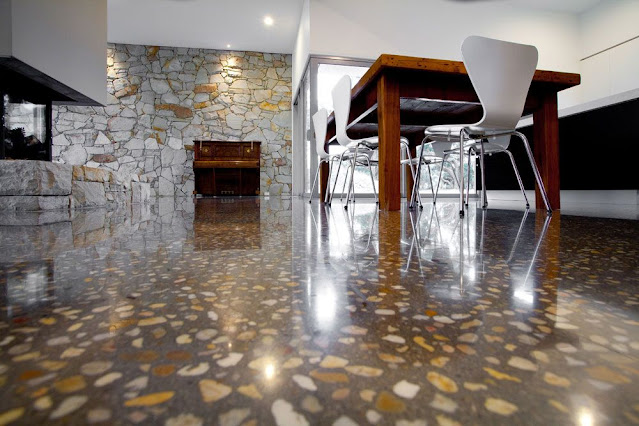Commercial Epoxy Flooring Melbourne is a highly durable and versatile option that can withstand heavy foot traffic, impacts, and spills without cracking or chipping. It is also resistant to chemicals, making it suitable for areas where spills are likely to occur. Epoxy floors are easy to clean and maintain and can be customised with various colours and finishes to match the decor of the space.
Installation of Commercial Epoxy Flooring Melbourne
Commercial Epoxy Flooring Melbourne installation involves cleaning and preparing the concrete substrate and applying the epoxy coating. The process can take up to several days, depending on the size of the area and the complexity of the design. The installation process requires skilled professionals who have experience working with epoxy flooring.
Maintenance of Epoxy Flooring Melbourne
Epoxy Flooring Melbourne is relatively easy to maintain, requiring regular cleaning and occasional resealing to maintain its shine and protect it from wear and tear. It is also important to avoid using harsh chemicals that can damage the surface. Epoxy Flooring offers a wide range of benefits for commercial and industrial spaces, including:
Durability
Epoxy floors are highly durable and can withstand heavy foot traffic, impact, and spills without cracking or chipping. They are also resistant to chemicals and abrasions, making them suitable for areas where spills and heavy machinery are common.
Commercial epoxy flooring is highly durable and can withstand heavy foot traffic, impact, and spills without cracking or chipping. This makes it an ideal flooring option for high-traffic areas like warehouses, factories, and retail stores. Epoxy floors are also resistant to chemicals and abrasions, making them suitable for areas with common spills and heavy machinery.
Low maintenance
Epoxy floors are easy to clean and maintain, requiring only regular sweeping or mopping to keep them looking clean and new. They are also resistant to stains, making them an ideal choice for high-traffic areas. This means that businesses can save time and money on maintenance costs and reduce the risk of slip-and-fall accidents caused by dirty or worn floors.
Aesthetics
Epoxy floors can be customised with a variety of colours and finishes, allowing them to match the decor of any commercial space. They can also be designed to create unique patterns, logos, or designs. This makes them an excellent option for businesses that want to create a distinctive look for their premises or to match their brand colours.
Safety
Epoxy floors are slip-resistant, providing a safe surface for employees and customers to walk on. They can also be made with anti-static properties to prevent the buildup of static electricity. This is particularly important in high-traffic areas like restaurants, retail stores, and factories, where there is a higher risk of accidents due to slips, trips and falls. Additionally,
epoxy flooring can be made with anti-static properties to prevent the buildup of static electricity,
making them suitable for environments that require electrostatic discharge (ESD) protection.
Cost-effective
Epoxy floors are cost-effective, with a lower installation and maintenance cost compared to other flooring options like tiles, hardwood, or carpet. Commercial epoxy flooring is a cost-effective flooring option,
with a lower installation and maintenance cost compared to other flooring options like tiles, hardwood, or carpet.
Businesses can save money on installation costs by choosing epoxy flooring, as it can be installed directly over an existing concrete floor without the need for extensive preparation. Epoxy flooring is also long-lasting,
which means that businesses can save money in the long run by reducing the need for frequent repairs and replacement.
Long-lasting
Epoxy floors have a long lifespan; proper maintenance and care can last several years without requiring replacement. This means that businesses can enjoy the benefits of epoxy flooring for many years without worrying about the cost and inconvenience of replacing their flooring. Furthermore, epoxy flooring is resistant to wear and tear,
making it ideal for high-traffic areas where other types of flooring may quickly become damaged or worn out.
Commercial epoxy flooring is a durable, low-maintenance,
cost-effective, and aesthetically pleasing option suitable for a wide range of commercial and industrial spaces.
The installation process of Epoxy Floors
The installation process of Epoxy Flooring in Melbourne generally involves the following steps:
Surface Preparation
Before the epoxy flooring can be applied, the surface must be properly prepared. This involves cleaning the surface and removing any contaminants or debris that could affect the bonding of the epoxy. The surface is then inspected for cracks, holes or other defects that need to be repaired before the epoxy coating can be applied.
Priming
The next step is to apply a primer to the surface. The primer is designed to enhance the adhesion of the epoxy coating to the surface and to create a smooth, even surface for the epoxy to be applied on. The primer is applied using a roller or brush and is left to dry for several hours before proceeding to the next step.
Mixing the epoxy
The epoxy is then mixed with a hardener to activate the chemical reaction that creates a strong, durable surface. The epoxy is usually mixed in small batches to ensure that it can be applied within the recommended working time.
Application
The mixed epoxy is then applied to the surface using a roller or brush. The epoxy is spread evenly over the surface, taking care to avoid drips or bubbles. If desired, multiple coats can be applied to achieve a thicker layer or a different finish.
Curing
Once the epoxy is applied, it needs to be left to cure. The curing time can vary depending on the type of epoxy used, the thickness of the coating, and the temperature and humidity of the environment. It is important to follow the manufacturer's instructions regarding curing time, as premature foot traffic or other use of the surface can compromise the durability of the coating.
Decorative Chips or Quartz
Decorative chips and quartz are two popular types of decorative aggregates used in epoxy flooring systems. While they are both used to enhance the appearance of the flooring, there are some differences between the two.
Decorative chips, also known as flakes, are small,
multicolored chips of vinyl or acrylic that are broadcast onto the wet epoxy coating. The chips can be blended to create a variety of patterns,
colors, and textures, and can even be customized to match a company's branding. Decorative chips come in a range of sizes, from 1/16 inch to 1 inch,
and can be used to create a light or heavy texture on the surface. They are a popular choice for commercial and industrial spaces, as they are durable, slip-resistant, and easy to maintain.
Quartz, on the other hand, is a natural mineral that is used to create a similar decorative effect. Quartz aggregates are typically used to create a textured or terrazzo-like appearance in the flooring. The quartz is usually broadcast onto the wet epoxy coating and then smoothed over to create a uniform surface. Quartz comes in a range of colors and sizes, from fine to coarse, and can be blended to create a custom look.
While both decorative chips and quartz can be used to create a decorative effect in epoxy flooring systems,
there are some differences to consider. Decorative chips are typically less expensive than quartz and offer a wider range of colors and textures to choose from. They are also more forgiving in terms of installation,
as they can be broadcast more easily and do not require as much precision. However, quartz is generally considered to be more durable and offers a more natural appearance. It is also resistant to UV rays and can be used in outdoor applications.
Both decorative chips and quartz can be used to create a decorative effect in epoxy flooring systems,
but the choice will depend on the specific needs and preferences of the business. Factors such as cost, durability, appearance, and installation requirements should all be considered when deciding between the two.
Top Coat
Once the epoxy resin and decorative chips or quartz are in place, a final top coat is applied. This seals the floor and provides additional protection against abrasions, chemicals, and wear and tear. The floor is left to cure for several days before being used. During this time, the epoxy resin fully hardens, resulting in a durable, long-lasting finish.
Finishing
Once the epoxy has cured, any imperfections or rough spots can be sanded down to create a smooth, even surface. A final topcoat or sealer may be applied to enhance the appearance and durability of the coating.
The installation of epoxy flooring in Melbourne requires careful preparation, mixing,
and application to ensure a strong, durable surface that will withstand heavy traffic and harsh conditions. It is important to work with a professional contractor who has experience installing epoxy flooring to ensure that the installation process is carried out correctly and efficiently.
















0 Comments